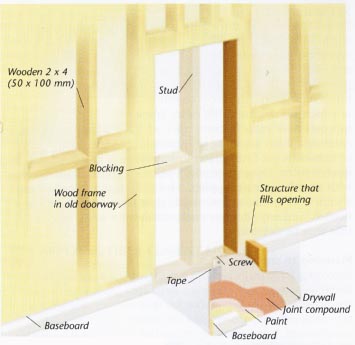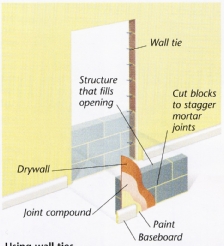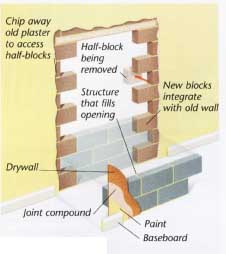Filling in an unwanted doorway can be done either with a 2- x 4-in (50- x 100-mm) stud frame or with blocks. It is best to fill in a stud wall with studs and a block wall with blocks, because these materials have different reactions to environmental changes, such as fluctuating temperatures or humidity levels. Using wood is easier, and can be done on a block wall if using blocks seems too difficult. But because the materials used do not match, cracks may later appear at or near the position of the old doorway. These can be filled and painted, but may reappear. By using matching materials, you reduce the risk of having these settlement or movement cracks appear.
PREPARING THE AREA
Remove the old door, casing, and door jamb before starting work on
the wall. Lift a door off its hinges or unscrew them from the doorjamb.
Remove the casing and door jamb with a claw hammer or pry bar.
When removing old woodwork, try to keep damage to the surrounding
wall to a minimum. It will greatly reduce the amount of finishing
work at the end of the project.
USING STUDS
This method for filling in a doorway uses the techniques shown here (Building a Stud Wall). Use lengths of 2- x 4-in (50- x 100-mm) lumber to line the doorway. In a block wall, use wall plugs and masonry screws to attach the studs to the blocks. In a stud wall, simply attach the new studwork to existing studs with wood screws. Insert more studs and blocking, to strengthen the frame: depending on the dimensions, a central stud and two blockings may be sufficient. Cut some square-edged drywall to fit the gap, and attach it to the wooden frame. Tape the joint between the new drywall and the surrounding wall with self-adhesive tape, and apply joint compound, feathering in the seam between the new and the old wall surfaces.
Finishing off
When the joint compound has dried, sand it to a smooth finish. Fill any holes with an all-purpose filler, and sand again, if you wish to for the smoothest possible finish. Attach new baseboard that's the same profile as the rest of the room. You can either use a short section to fill in the gap and match the adjoining boards, or replace the baseboard along the whole wall.

Above: Using wood to fill: This method is easier than using
blocks. It is normally used in a stud wall, but can also be used in
a block wall. Both wall types are shown here.
USING BLOCKS
Blocks can be laid in the opening, using screw-in ties to secure them to the existing blocks, or you can remove blocks at alternate levels from either side of the opening, in which case the new blocks will automatically be securely attached to the existing wall. Both methods are shown to the right. Once the wall has dried, remove any loose material before attaching drywall panels and feathering in the edges with the existing wall edge. When the joint compound has dried, sand it, paying particular attention to the seam between the old compound and the new. Decorate, and attach a piece of baseboard across the old doorway, or replace the full length.

Above: Using wall ties: Build a small block wall. Match the
depths of mortar beds to those on the existing wall, so that wall ties
inserted in the old wall’s mortar align with the new mortar courses.
The blocks will not be an exact fit across the doorway: work out where
cuts will be needed. (Structure that fills opening; Joint compound;
Paint Baseboard)

Above: Removing half-blocks: This method takes longer
than the wall-tie one. Use a club hammer and bolster chisel to take
out half-blocks from the edge of the doorway. Chip away any hardened
mortar. Then insert new blocks. If they aren't an exact fit, make
cuts, or add slightly more mortar, to fill the space appropriately.
(Chip away old plaster to access half-blocks; Half-block being removed;
Structure that fills opening; New blocks integrate with old wall; Joint
compound; Paint Baseboard; Drywall )